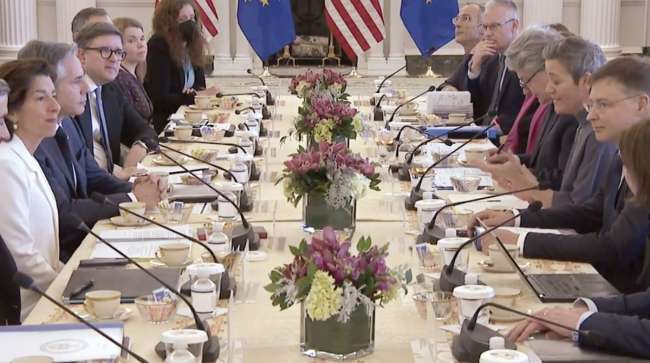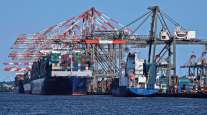Staff Reporter
US, EU Discuss Semiconductors, Cybersecurity, Supply Chain

[Stay on top of transportation news: Get TTNews in your inbox.]
The U.S. and European Union agreed during a recent high-level meeting in Washington to increase raw material sourcing for semiconductors and better align mutual cybersecurity protocols for infrastructure and businesses.
American participants in roundtable discussions during the fifth US-EU Trade and Technology Council (TTC) included U.S. Secretary of State Antony Blinken, U.S. Commerce Secretary Gina Raimondo and U.S. Trade Repredsentative Katherine Tai. The EU was represented by European Commission Executive Vice Presidents Margrethe Vestager and Valdis Dombrovskis as well as Thierry Breton, internal market European commissioner.
“For economic security, I think there’s a common recognition that we must continue to de-risk our economies, to diversify further our supply chains, to focus on common threats — including authoritarian governments that may misuse technology,” Blinken said in opening remarks. “And this is maybe one of the greatest shared challenges we face and concerns that our citizens have, because it’s something that affects them every single day in their lives.”
In a joint statement, Breton and U.S. Homeland Security Secretary Alejandro Mayorkas said: “We strongly welcome the close cooperation between the European Union and the United States to secure our people, critical infrastructure and businesses against detrimental cyber activities. In a geopolitical and technological landscape marked by the proliferation of new threats and malicious actors, it is paramount that we continue to cooperate and join forces to promote our shared values and objectives in cyberspace.”

Thierry Breton (left) and Alejandro Mayorkas
Their action items are to align as fully as possible requirements and guidelines issued to reduce the cybersecurity “compliance burden” for businesses.
“This [activity] includes publishing a joint product comparing our cyber incident reporting frameworks for critical infrastructure, including fields of information and the timing of such reporting, so as to identify areas where we are aligned and where there are divergences,” the statement noted.
Both the U.S. and EU committed to work together and with interagency partners to prepare better collective crisis response mechanisms to cyber incidents, including situations needing rapid and effective support.
They also plan to jointly “advance the cybersecurity of software and hardware in critical cyber policy fields so as to best prepare public administration, businesses and critical infrastructures for evolving future threats.”

von der Leyen
The next meeting of the TTC will take place this spring in Belgium. The forums are the main gathering in which U.S. and EU counterparts coordinate transatlantic trade and technology issues. The TTC meetings were launched in 2021 by President Joe Biden and European Commission President Ursula von der Leyen to improve cooperation on matters of mutual interest.
U.S. government leaders also emphasized additional areas of cooperation such as strengthening “our collective economic security” by building resilient supply chains and coordinating more on “export control regimes to prevent the exploitation of dual-use technologies.”
How does hydrogen fuel cell technology fit into freight transportation? Find out with Parker Meeks, the CEO of Hyzon, a company that designs and manufactures fuel cell technology for heavy-duty transport applications. Tune in above or by going to RoadSigns.ttnews.com.
A European Commission statement after the talks revealed the EU and U.S. are “intensifying their coordination on the availability of critical raw materials crucial for semiconductor production, having activated the joint TTC early warning mechanism for semiconductor supply chain disruptions, following China’s announced controls on gallium and germanium.”
Along with TTC discussions, both the United States and EU hosted two related stakeholder events. One discussion was called “Roundtable on the Legacy Semiconductor Supply Chain.” According to the Commerce Department, U.S. and EU industry leaders discussed how companies can improve supply chain resilience and transparency. Other topics were ways governments can address nonmarket policies and practices that result with being excessively dependent on a country with a history of semiconductor production.
The final event, “Crafting the Transatlantic Green Marketplace,” dealt with how to strengthen the transatlantic marketplace to develop sustainable and net-zero-carbon-emission economies on both sides of the Atlantic.
Want more news? Listen to today's daily briefing below or go here for more info:





